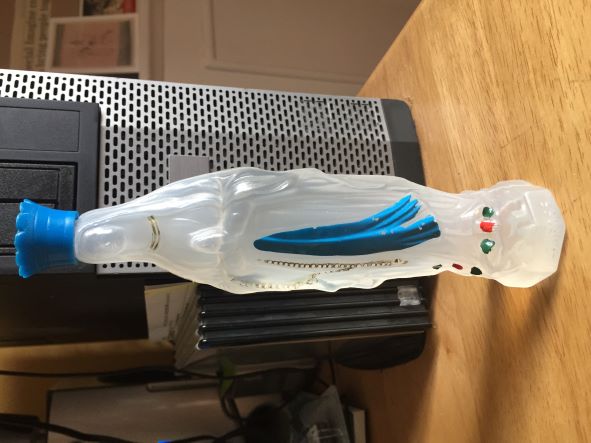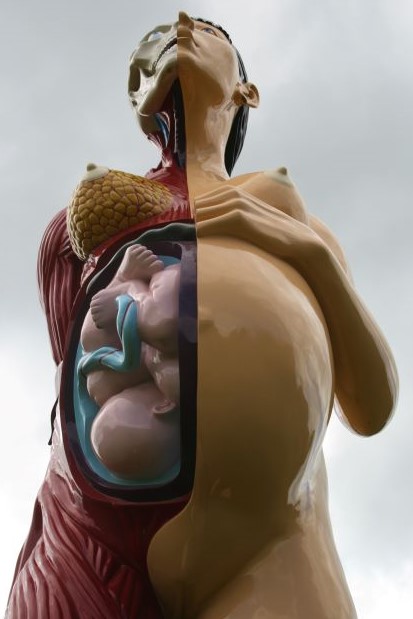
"As an object moves from one person to the next, from one social setting or one culture to the next, it acquires different values and associations, negotiating differences and carrying with it veneers of significance..."
‘The materiality of cultural construction’ (2008) David Morgan. Material Religion (vol. 4, no. 2, pp. 228–9)
This is a plastic bottle in the shape of Mary, the Mother of Jesus, which I either bought pre-filled or filled with water (can't remember which) at the pilgrim site of Lourdes in the summer of 1987 and then brought home as a 'souvenir' for my parents. It is now back on my shelves as I'm clearing up my mother's flat for sale now that she has moved to residential care.
I've decided to think through some of the ideas Morgan describes as the 'social career' for this object.
This was an object I bought thirty-six years ago aged 22, I had (privately at that point) decided to become an atheist perhaps two or three years before - having been brought up a Methodist. I had travelled to Lourdes as the nearest rail station to Gavarnie in the central French Pyrenees where I had planned a short solo walking holiday. I can remember that Lourdes surprised me, I found both the commercialisation of the 'pilgrim site' and the whole scale of the Roman Catholic imagery and 'performance' of pilgrimage quite disconcerting. It is one of very few locations I've been to where religion and faith are such a fundamental aspect of a place
now, informing everything from what is on sale in the shops to the names of the hotels.
I think I only stayed overnight (can't remember where - presumably camping) I saw the Grotto from outside and people collecting water from a set of taps, I wandered through a huge subterranean church. I didn't attend any services or explore any of the available 'St Bernadette' tours or activities, but I did witness a number of physically disabled young people being wheeled to the shrine - I recall that being a rather humbling experience as I'd been feeling very superior, amused by all the 'tat' on sale in the shops (mints, 3-D Jesus pictures, snow-globes etc...).
(Far from uniquely!) buying souvenirs of holidays is a tradition in our family, essentially established and maintained by my mother. We collected objects, created scrapbooks etc. and I think it is chiefly in that tradition that I initially purchased the object. It was in my price range, portable, locally appropriate and a 'conversation piece' when I got home - I think I often look for objects that I somehow feel 'embody' a place. For me, at that point, its 'meaning' was simply an example of exotic kitsch Catholicism, different from any of the religious symbolism I had grown up with - and additionally it contained the 'magic water' which I could contrast with the scientific rational beliefs that I was acquiring (I had just finished my first real research training).
The initial setting for the 'Mary bottle' will have been in a shop, presumably alongside other versions of the same object and surrounded by other pilgrim souvenirs - a sort of secular/quasi-religious space dedicated to commerce based on either faith or tourism (or both). I wish I could remember for sure whether it came pre-laden with water, or whether I filled it up at the taps - I think it was the latter, but I really can't say for certain now.
For the next thirty years of so the 'Mary bottle' lived on a shelf in my parents front room, one of a number of souvenirs and family mementos. It didn't have any particular position of importance, and would have sat alongside 'a gift from [insert]' pottery - my memory is of it being reasonably out of reach, certainly not put anywhere that implied accessibility was important. I haven't asked Mum specifically what meaning the object held for her over that time, but what came up when I mentioned it were her memories of
me at around that age. Whilst the water level in the bottle is not full to the top, I've no sense from her that she made any use of it and no doubt this could just be a consequence of evaporation - or perhaps it was never completely full. It wouldn't surprise me if she had chosen to use the water however, she and my father faced a number of significant health problems, there are aspects of Mum's thinking that are quite 'magical' and whilst her non-conformist faith held little truck with 'fancy stuff' there was always an ecumenical strand to her religion.
However, I think the most likely meaning the object held over all this time was 'me' - one of a set of objects around the house that reminded my mother of her son. I realise I've left Dad out of these reflections, but 'nick-nacks' were very much Mum's domain - at most Dad would get involved in making a bespoke 'device' to support something, or perhaps in mending any breakages - I don't know for sure, but I'd guess the object had little significance for him.
Over the last five years the object has been on the bedroom window-sill of my mother's flat - she relocated to Yorkshire from Devon after several years living alone. Interestingly, the 'Mary bottle' survived what was a very significant clearance of objects at that time as she downsized to a single bedroom flat. In fact the majority of Mum's ornaments went either to charity shops or refuse, including many of the objects I might have bought. I've no sense of why this object was retained and whether that implied any change in its meaning at that point. I wonder if the fact that it was a 'religious' object made it hard to simply throw in the bin and it was kept by default (it was unlikely to be of value to Oxfam for resale!). However, I also know Mum finds it hard to accept my atheism (which we only really discussed fully about a decade or so ago) and I wonder whether it held significance for her as an object that reflected an earlier time when she thought we shared a faith - again not something I have been brave enough to ask about.
Now however Mum shows no signs that she wants the 'Mary bottle' in her new single room within a residential home. Family photos, plants and flowers are the only objects that she now regularly has around her - and seems happy with this. I know she now has more significant religious doubts than at other times in her life and whilst she had a number of faith-related objects and books these aren't things which she currently appears to want to interact with. When we talked about the bottle recently it led mainly to memories of my travels and visits home and I'm sure this was always its chief significance for her.
So it comes back to me - back to a shelf, now in my study. Right now its meanings are all wrapped up in this reflection and as a consequence the object will probably continue to hold a connection with OU study and an 'academic' consideration of religion. It is also a link back to my (relative) 'youth' and the time and place it was first bought and, of course, to my own relationship with my mother. It has no connection to any super-natural realm, nor do its contents. I will certainly keep it whilst my Mum is alive - after that I'm unsure, it's time for a review of much of the clutter that I have collected that, whilst it may trigger memories for me, will have no meaning for any of my children. I see no likelihood of my returning to a religious faith - but perhaps its association with healing may also contribute to my retaining it - a reminder that there are many different ways beyond the scientific in which health is considered.
So, this object which 'in principle' is a Christian pilgrimage souvenir containing 'holy water' imbued with a healing power has most of its current meanings entwined with family dynamics and personal memories of an earlier life of exploration and discovery now complemented by an intellectualisation of culture and the arts.
